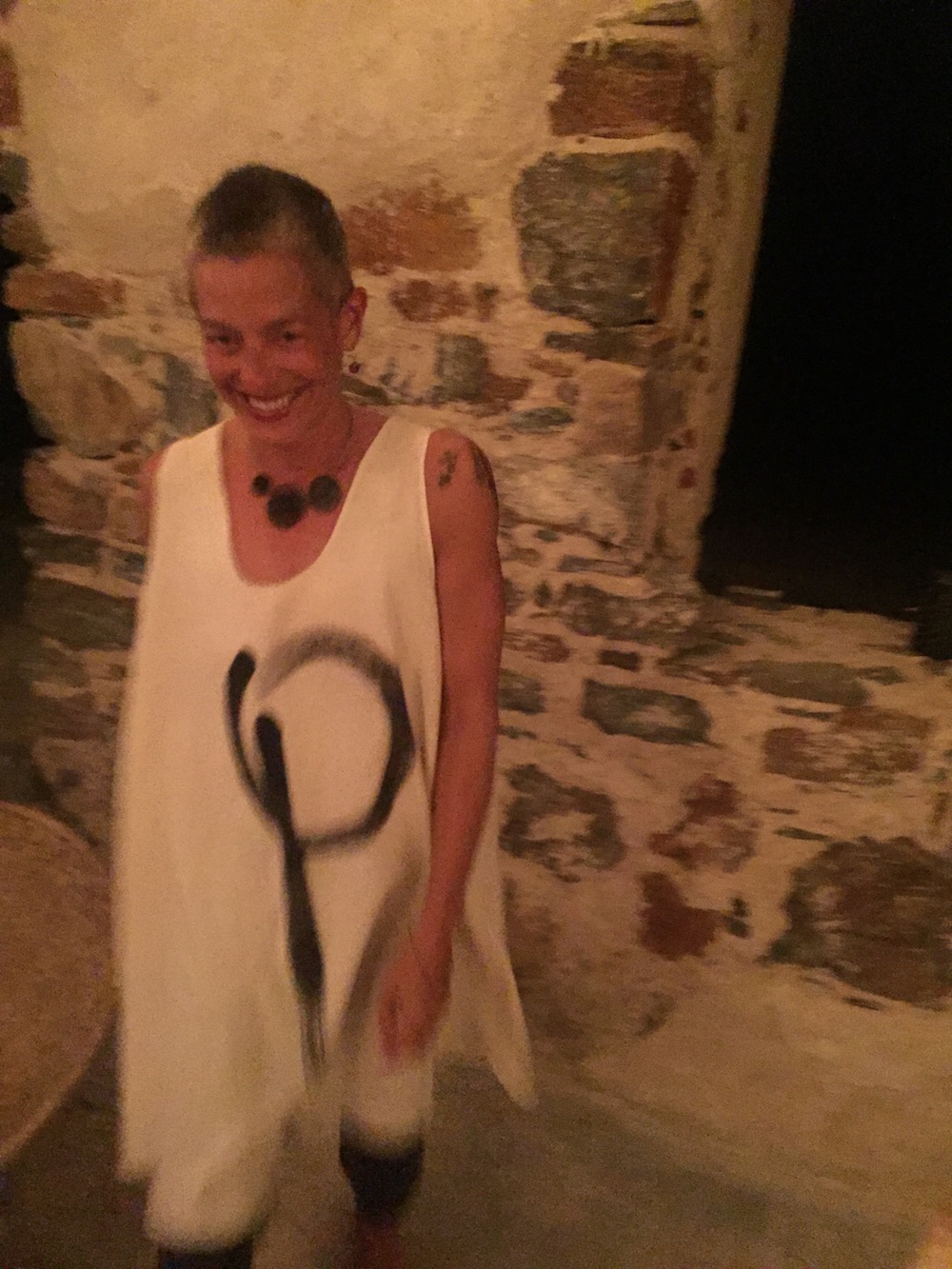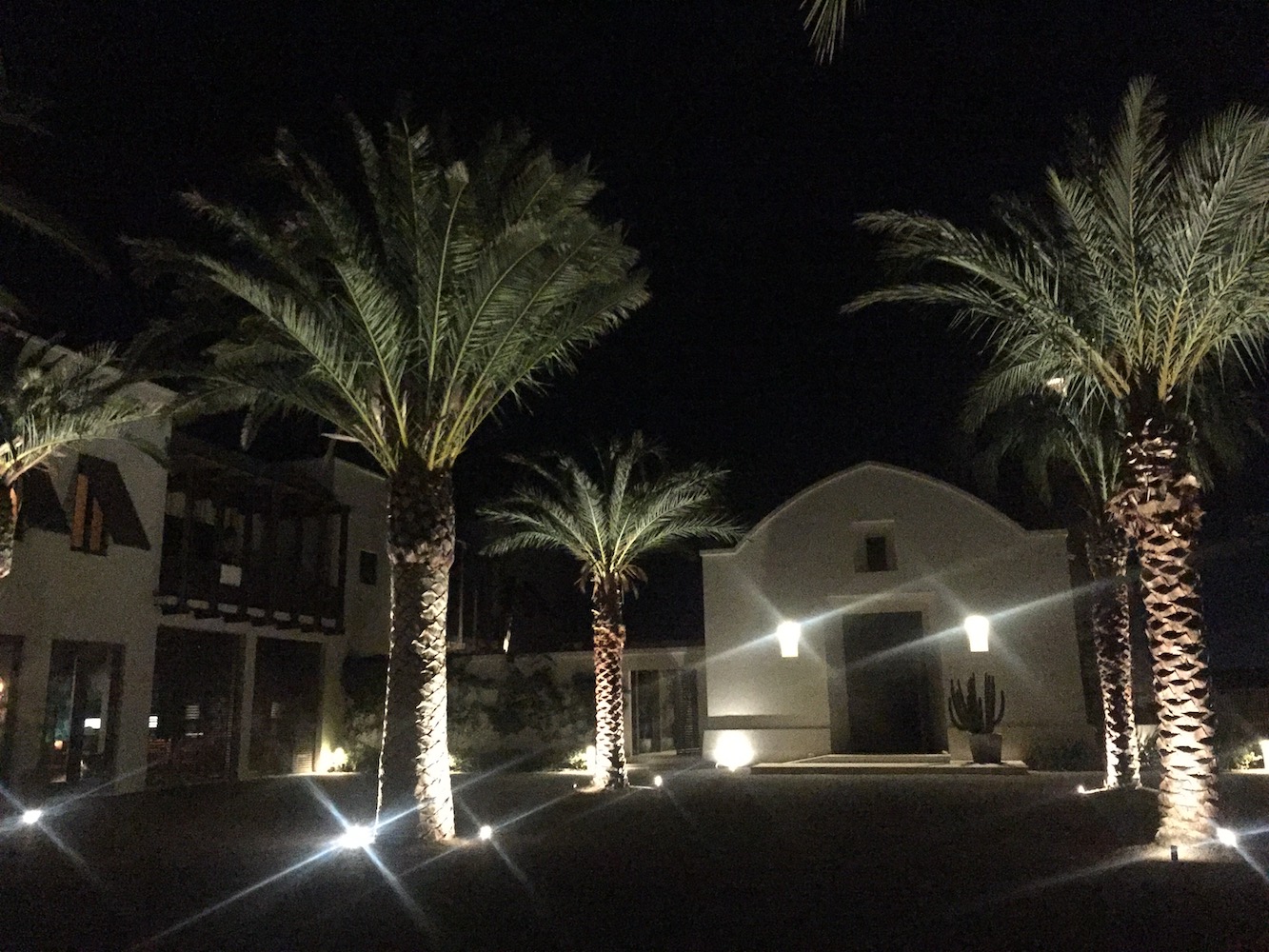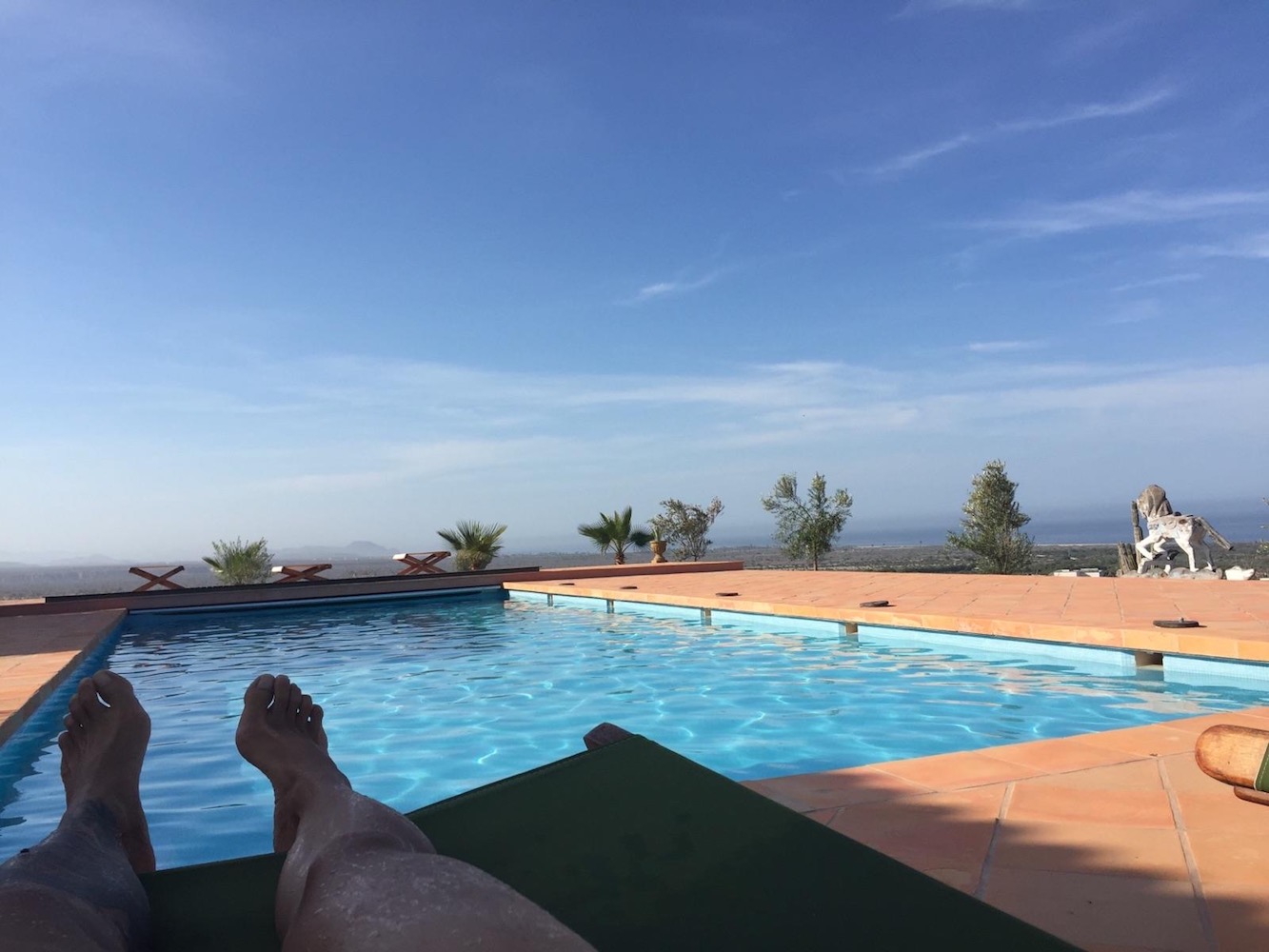my ATV (all-terrain vehicle) parked out back of Mansión de las Azahares, Las Playitas, B.C.S.
Today I rode my ATV over to Catia's house to meet her for a Saturday afternoon in Todos Santos. Catia Asirelli de Melandri has been living off-grid in the Sonoran desert for the past 14 years with her husband, Paolo, since closing their restaurant in Marina di Ravenna, Italy. In the year that we've known them, Kevin and I have become enamored of their lifestyle -- a life centered around good food + good friends. We've had countless meals at their casa, first-class dinner parties that prompted our invitation to Catia to host the gala dinner for our first workshop at Taller de Terreno (TDT). scheduled for January 2019.
Catia had three stops planned for us: a pop-up shop of two collaborating artist-friends of hers, Rancho Buen Dia for ensalada, and, as always, Mercado Del Sol for anything left we'd forgotten. The day, like most here, was stunningly sunny and warm, with an ocean breeze arriving right on cue to cool down the sizzling sandy camino to our first destination: the studio of textile designer and artist, Javier Lario Díez.
Just back from Spain, Javier had immediately reunited with collaborative partner, painter Gloria Santoyo Ruenitz. This would be only their second line of garments designed and produced together, and as we entered the breezeway leading to the detached studio building, I could see the airy, contemporary fabrics blowing in the brisa.
collaborative work of Javier Lario Díez + Gloria Santoyo Ruenitz, know as Artetela
Catia zeroed in on a hand-dyed indigo table covering of organic cotton, and I was drawn to the loose-fitting pants created by Javier and dashed with Gloria's signature zen brushstrokes. Instead I bought a white cotton shift dress with Gloria's free-handed, generous om symbol as a not-so-subtle reminder to myself (and others!). Off to the mercado with us. I changed into the dress -- no time like the present -- ommmmmmmmmmm!
brushes, studio of Gloria Santoyo Ruenitz
Ranch Buen Dia, really just a covered stall, or palapa, in front of a small, organic vegetable farm, had their fabulous Super Food greens, but no tomatoes. And while Mercado El Sol has almost everything you can think of (disclaimer: for a small village in Mexico), produce is bought there only as an afterthought. "El Sol Dos", as the locals refer to this their second location in town, is more for leche, huevos, totopos and cerveza (ALL important words en Español ~ better look them up!), and is usually jammed up at the register with touristas counting change.
Three stops turned into four. Only in-season fruits and vegetables are sold here, and tomato season had apparently just ended "What!? Already?" (me, shocked). "Too hot now," came Catia's quick reply. I felt pretty lucky that our maestra was able to find suitable specimens at all for the meal she had planned for tomorrow, since there are only a few markets in and around town selling produce, and we'd gone to two of our trusted standbys already. We had success at the fourth stop, and soon were bouncing back up the washboard road to Las Playitas, five miles north of Todos Santos. Traffic report: two horses and a mule moving slow up ahead, small herd of cattle + one bull at the final bend near the Cota family ranch house.
We separated our bags back at Catia + Paolo's, with assurances from me that I'd be back with Kevin in a few hours. We had a dinner date at Hotel San Cristobal for their Buena Pesca seafood event. (I planned to wear my new shift with a few added "evening touches", perfect beach dress!)
The antique abalone cannery on the Hotel San Cristobal grounds
By 7:30 we arrived, hungry, at the property of Hotel San Cristobal. Paolo and Kevin led the way down the candlelit path to the ruins of an antique abalone cannery. The event promised all-you-can-eat chef specials, prepared on the spot, and bottomless wine glasses, so Catia and I had to hustle in heels through the beach grounds to keep up with the men's party-pace. The sounds of thumping live reggae music mingled with charcoal grill scent, and after snapping a few quick photos I quickly made my way to the food.
dinner crowd at Buena Pesca, 28 July 2018
Hanging lights, people everywhere, small plates lining the tables and bar. Didn't take me long to draw a mental map of the place: traffic this way to bar, get in line with a plated salad while waiting for soft, delicate white-fish tacos topped with fermented cabbage salsa; eat salad while waiting, grab another on way back to table, try the fresh corn tortilla with the rice.
Guest Chef Alberto Collarte of Cabo San Lucas
Chef Alberto Collarte is from Santiago, Chile, but now lives + cooks in Cabo San Lucas. We were all eager to taste his creations for tonight's menu, "inspired by the ocean's offerings," as the hotel's handbill proclaimed.
My favorite was his curel, or yellowtail, sashimi prepared on a Himalayan salt block (lit Hallowe'en-style from below) and garnished with a creamy citronette. I could taste a hint of salt on my tongue, balanced with sweet fish and more complex acidity of the citronette.
The evening ended with a round of group photographs + cheering from the chefs + sous-chefs. Mexicans know how to celebrate, I assure you.
my new Om dress, by Artetela, necklace by Joy O
As mentioned earlier, I wore my new dress from the pop-up, and I couldn't help but notice more people smiled at me while I was wearing white...or maybe it was the Om sign? My night was lit in many ways, the sparkle of the candles was contagious, and we all drifted into the night. Kevin and I wandered down to the beach through San Cristobal's Hotel + pool area, a palmy environment centered around the largest swimming pool I'd seen yet in the Todos Santos/ Los Cerritos Beach area. Couples still sipped drinks in the pool's inner sanctum of twin jacuzzis. The darkness enveloped the coastline, but the pull of the tide was ominous from so close to the ocean's edge. It was hard to leave its overwhelming presence and get back into our truck.
Hotel San Cristobal and La Capilla, the hotel’s beautiful chapel and event hall
Sunday morning came on fast and bright. Luckily I didn't have to do much, and even a late lunch was being prepared for me at 2 o'clock (okay, not just for me, it was actually in honor of Chef Alberto, his novia, and his madre, who had stayed the night in Las Playitas as guests of Catia + Paolo.)
Lucky them! Lucky us!
Kevin + I arrived at Catia's at 2pm sharp the next day, so as not to miss the fresh focaccia from the oven that ~ Catia had already messaged to tell me ~ was going fast among the foodies. Pasta with tomatoes and the last of this year's reserve of bottarga (the Italian name for a delicacy of salted, cured fish roe) was plated after an appetizer of pargo carpaccio, fresh red snapper.
Catia's unforgettable Bottarga Spaghetti
I had been looking forward to the Bottarga Spaghetti all week, once I'd found out Catia was breaking out the last of this year's "gold brick from the sea." This signature dish of Catia's prompted me to ask her a few questions about her background:
Taller de Terreno (TDT): Where were you born, and were you raised in this same city?
Catia Asirelli de Melandri: I was born in Ravenna in Emilia Romagna, Italy, and raised in the same city. I moved from Ravenna when I was 18.
TDT: Who or what meal is your earliest memory of influential cooking?
Catia: My grandmother Adele with her love for food. She made Emilia Romagna traditional cuisine as Lasagne with truffle (her masterpiece!) or Passatelli in fish broth (you can eat that delicious homemade pasta only in Romagna). Actually, I'm not a traditional Italian chef, but I learned from her that to make good food I need fresh ingredients, time, a good vision of the life and love. Thank you, Nonna!
TDT: Did you always want to be a professional chef?
Catia: No, I never wanted to be! (laughing)
TDT: How many restaurants have you owned, and where?
Catia: I owned 2 restaurants with my husband: Miraflores in Ravenna in 1982, it was the first restaurant in the city serving tapas. It was inspired by our trips to Spain and Morocco.
Kon Tiki Beach Club in Marina di Ravenna, [est.] in 1994, was an innovative restaurant at the beach serving dishes from the world cuisine and Emilia Romagna traditional food. It was the first restaurant serving sushi in that area. We made a food revolution there! (laughs again)
I used to take inspiration from our trips [taken] in the winters when the Beach Club was closed. Every summer we had new dishes, everything fresh and homemade, the menu' wasn't written on paper but it was sung by the beautiful young girls at the table because the menu changed so fast -- some days from lunch to dinner, depending on the fresh ingredients we found each day.
In 1992 I spent almost 2 years in Santa Monica, California, having fun cooking and managing a few restaurants in town. The funniest experience was in an Italian Restaurant (I don't remember the name), I made ONLY side dishes (contorni in italian) and everybody called me 'the contorni woman'.
I prepared 25 different side dishes using only fresh vegetables, I was in the middle of a round table making them with a waiter serving them directly from the table.
TDT: What was your favorite dish on the menu?
Catia: Spaghetti alla Bottarga, Carbonara Fish Spaghetti (my personal version of Carbonara with fish instead of pancetta), and a delicious Fish Curry.
TDT: How long have you lived in Baja Sur?
Catia: I came here the first time in 1992, I was working in Santa Monica (CA) and my husband come to visit me from Italy. We decided to spend a vacation of one month in the Baja Peninsula, then we began to come every year for a few months. We moved here as residents in 2005.
TDT: Where in the world would you like to go to sample local fare you've never tried?
Catia: I'd like to go to Indonesia, Japan and Vietnam to taste the food and to learn more. We scheduled this trip for the end of next year.
TDT: What do you like best about Mexican cuisine, and how have you adapted your Italian recipes to reflect your new culture?
Catia: The sauces, the maíz tortillas, fish tacos and the fantastic seafood dishes. The Mole is a masterpiece, it's an ancient and ancestral recipe of the Oaxaca region cuisine, my favorite place to eat in Mexico.
When I come back after a long trip outside of the Mexico I like to eat Sopa Azteca because it has all the flavors of Mexico!
TDT: How + where did you become friends with Chef Alberto Collarte (of Buena Pesca?
Catia: I met Alberto 5 or 6 years ago in my house. I went to a dinner with my girlfriends and when I came back at 11 pm I found Alberto, his friend Mauricio from Chile, and Cristian, a young Italian chef working in Cabo San Lucas. Mauricio wanted to start a wine business here, and Cristian knew that an Italian man in Todos Santos made wine -- he got Paolo's phone number from a common friend in Ensenada.
That afternoon Cristian called Paolo asking advice about how to make a wine business in Baja. Paolo asked him where he was, he said, "Right now I'm in La Paz with a friend who wants to start a wine business and another chilean friend, a chef and we'll go back to Cabo around 5 pm.
So Paolo invited them to stop to our house on their way back to Cabo giving him the directions to come through the desert.
You can imagine their surprise and happiness to arrive at our house from a road they didn't know, it was autumn, the desert so green, and they arrived for the sunset!
They fell in love with Las Playitas and we became good friends. After 2 years, during a Sunday lunch here, they bought a piece of land next to us: Paolo called a lady who was selling it and they decided the price and bought the land by phone!
That night I met them they were enjoying Fior diVino [Catia + Paolo's own wine] and they hadn't eaten yet so I made for them the fantastic Bottarga Spaghetti at midnight. They were the happiest guys of the Baja California that night ~ and a new friendship was born!
Pura Vida! Gracias, Catia y Paolo!
Catia Asirelli de Melandri will be cooking one very special meal for the close of Taller de Terreno's kick-off workshop (coming January 7-18, 2019). She assures us she will return to Italy this summer to get more Bottarga. Spaces still available for the workshop. Reserve your space HERE now.











